Saturday, October 27, 2007
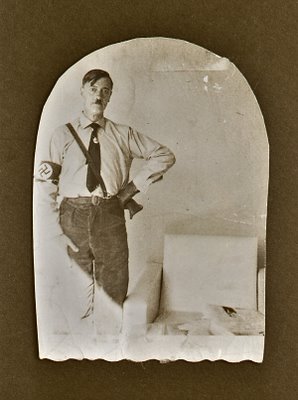 The day before yesterday when I was in my H,I,J files looking for the negatives for Friday's blog I was jolted, as I always am by the file labeled Hitler. And every time I file them away again and conveniently forget about them. I am not even sure these negatives,I copied an original photograph, represent an authentic one. But this blog offers me some sort of justification for showing the picture. The negatives are in my files because some years ago Jim Christy wrote an article for Vancouver Magazine about Robert George Wilson, who in 1984 had written Confessions of Klaus Barbie , Pulp Press, 1984. Klaus Barbie was known by the epithet, the butcher of Lyon. He wrote it for Vancouver Magazine. I met Wilson and he lent me his Hitler photograph so that it could be reproduced in the Christy piece. Since there were no scanners at the time I had to use a few photographic tricks to make the faded picture look decent. As I wrote in Evil At The Piano I have that memory of being 6 and being told as I was being combed my mother that I looked like Hitler. A couple of years later I was invited into the house of my friend from across the street on Melián in Buenos Aires. His name was Mario Hertzberg. We called him el alemán , I was el inglesito and our mutual friend Miguelito was el tano as he was Italian). I had no concept of Jews or what being Jewish was all about. In Mario's house I spotted a portrait of a fat Mario on the wall. I smiled and pointed it out to Mario. Mario said, "That is not me. That is my older brother. He died in Auschwitz during the war." I asked how he was killed but Mario never said anything more. It was quite a few years later that it dawned on me what had happened and how the Hertzbergs had somehow survived without that one son (Mario had two much older brothers who lived with him) and moved to Argentina after the war. Jim Christy Odd Pattern
Dennis & Frank
Friday, October 26, 2007
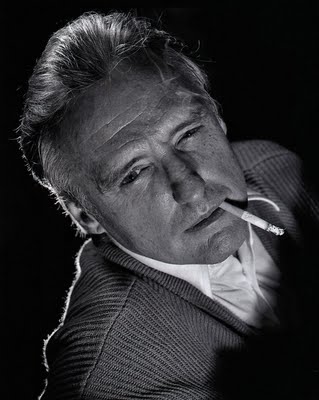 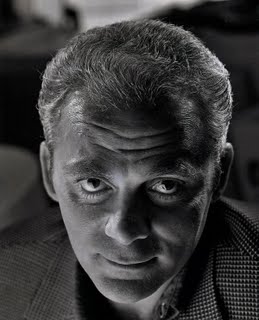 One is an actor the other is a shrewd businessman. Both could play hoods just fine. The actor was smooth and while he only drank Perrier in my presence he wouldn't let go of his Kool mentholated cigarettes. The businessman looked like a hood and spoke like a hood. When I mentioned some of my hood friends from the Ricci, De Cottis and Dal Monte families, their names did not register on his face. He was that good. As it turns out the would-be hood (of my imagination) is a very smart cookie who has made millions for Lion's Gate Entertainment Corporation and helped make our city Hollywood North. None Nicer
Penguins In The Sahara & David Hughes
Thursday, October 25, 2007
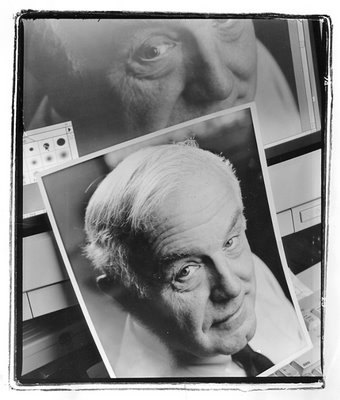 David Hughes was born and educated in England, graduating from Cambridge University with an honours degree in 1957. He entered the emerging commercial computing industry with ICL as a programmer and system analyst. Prior to this he served in the army and reserve army under National Service leaving with the rank of Captain. He emigrated to Vancouver in 1966 and served in management capacities for Canadian General Electric, BC Tel, MIS, the Computer Communications Group, CUE Datawest, and Sierra Systems Group. David Hughes was born and educated in England, graduating from Cambridge University with an honours degree in 1957. He entered the emerging commercial computing industry with ICL as a programmer and system analyst. Prior to this he served in the army and reserve army under National Service leaving with the rank of Captain. He emigrated to Vancouver in 1966 and served in management capacities for Canadian General Electric, BC Tel, MIS, the Computer Communications Group, CUE Datawest, and Sierra Systems Group.
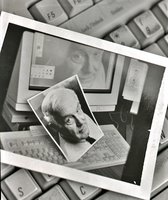
He has wide experience in serving on industry boards as well as advisory boards to government and academia, where he provided a private sector perspective. Mr. Hughes is an avid boater who sailed for many years and now owns a small power boat.I never quite understood exactly what David Hughes or his company Sierra Systems did at the time that I photographed him for a business magazine. I don't even remember for what magazine it was. I have dates in all the filed envelopes with negatives but this one had no date. I have no tear sheet that includes this photo but I do remember that I took this photos when my knowledge of computers was close to zero. I logged on to the internet in January 1995 but I believe that this photograph is at least 15 years old. I tell my students at Focalpoint in my perennial class, The Contemporary Nude Portrait, that it is important to photograph the nude to understand what the body does in different positions. With experience and knowledge on how the nude body moves and how limbs flex one can then properly photograph clothed people. It is no different from the training that artists get at art colleges when it is mandatory that they do live drawing. I went with a straight portrait of David Hughes to my designer friend Ian Bateson and told him what I wanted. Because Bateson, of Baseline Type & Graphics is also an artist and had gone to art college in London, his knowledge on how flesh falls and moves helped him manipulate realistically(Bateson was an early pioneer in the use of Photoshop) my print to make Hughes gaze on himself. I gave the magazine two choices but in the end they used the simpler one seen here, top left. My friend Grant Simmons (below) at Disc Imaging Group is also very good at Photoshop. I go to him for the printing of my slides as beautiful giclées or for the scanning of slides and negatives to make large prints. He has a light touch and firmly believes, as I do, that just because we can put penguins on a Sahara Desert dune, does not mean we should do it. 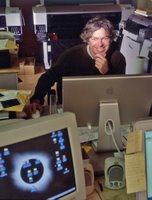 More so than ever photographers have to justify special effects and first satisfy their own personal standards and ethics. My photojournalist friend Nick Didlick once told me, "The only way you can believe the truth of a photograph is not to trust the reputation of the newspaper or magazine. You must know the photographer." Photographic Misconception TwiceWinner & Loser
Wednesday, October 24, 2007
 My Norman 200B is so important in my photographic life that I have three of them. All three are at least 25 years old or more. There are all kinds of stories that photographers tell (or at least they used to tell when there were enough of them for a friendly beer quorum) about being in the middle of Alberta on an annual report (when forestry companies were rich enough to have annual reports). They recount of a sudden loss of power in mid shoot of one's rented studio lights. What to do? And then the photographer remembers that there is a little case in the car, or back in the hotel with a Norman 200B. Salvation is at hand and the assignment is successfully finished. Which proves that a small light can go places if it works all the time. My Norman 200B (actually a pair of them in a metal photo case) has come to the rescue. In May I broke my left elbow. I have been unable to stretch out my left arm completely. My therapist measures the angle by subtracting from 180 degrees. A month and a half ago I was at 27 degrees. With Torquemada type techniques they got that down to 22. But now Maureen my therapist at VGH is measuring 18 and 17 with her special protractor. She looks at me and smiles, "Norman is helping lots." For the last month I have been walking around the block twice a day and wherever I go I carry my metal case containing the two Normans. Maureen suspects that intermittent exercise makes no difference if measured in minutes. But walking with the Normans over longer periods of time is making that difference. The average person seeing the picture here, that I took of Rebecca in Rosemary's kitchen garden in August, would not suspect that I used an artificial light. But I did. It is lit by a Norman 200B inside a 3x4 ft softbox (it's like a tent) and the sun while present was playing second fiddle. 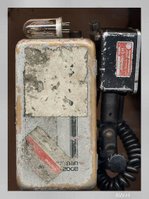 I never became an engineer because I failed electricity in university. My bête noire was my inability to differentiate among resistance, inductance and capacitance. Little I was to know then that some day I would come to understand exactly what capacitance is all about and that what makes my Normans great battery-powered flashes is that they have dependably tough capacitors.
Tuesday, October 23, 2007
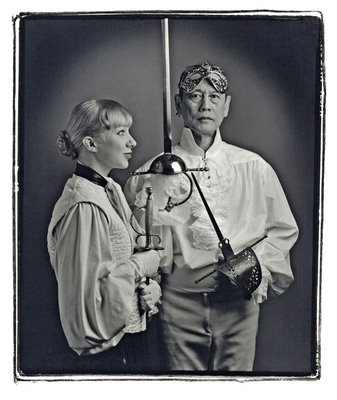 Cambodian-born fencing master, Maítre Bac Tau begen his career in 1965 with his Diplôme de Moniteur d'Escrime, from the Ligne de L'Académie d'Armes de Paris. Not only did Maítre Bac show talent but the head of the academy warmed to the young man, telling him, "My father taught your King, Nordom Sihaneuk, to fence." (Sihaneuk was better-known as a trombone player). Maítre Bac, a member of the Coaching Commission of the Academie d'Armes Internationale, has written books on fencing, from the classic The Fundamental Principles and Techniques of Foil (1985) to a useful The Manual for the Care and Repair of Electric Fencing Equipment(1996). He is central to the Vancouver fencing scene. As serious as this might be, fencers never forget their childhood roots. And they do so with a smile. Maítre Bac confessed that when he was six he cut his first bamboo stick so he could play Zorro. He agrees that the longest and best scene in the movies is in Scaramouche, in which the dashing Stewart Granger, in full Technicolor vanquishes Mel Ferrer at the Paris Opera. Maítre Ba cites The Fencing Master, a 1993 Spanish film based on Arturo Pérez-Reverte's novel El Maestro de Esgrima as the most authentic. Why is Maítre Bac's 18-year-old-pupil, Maja Futrell-Frühling smiling in the photograph? The aspiring actress says it is great for an actor to have the ability to fence. With a smile she said, "Besides being a sport, you get to poke people with a swords, it is good stress relief." An ideal pursuit for anyone who, as it says in the opening line from Rafael Sabatini's Scaramouche, "was born with a gift of laughter and a sense that the world was mad." The above appeared originally in the July 2007 issue of Vancouver Lifestyles Magazine. SwashbucklersMore
Delirio Amoroso - John Eliot Gardiner & Pacific Baroque Orchestra
Monday, October 22, 2007
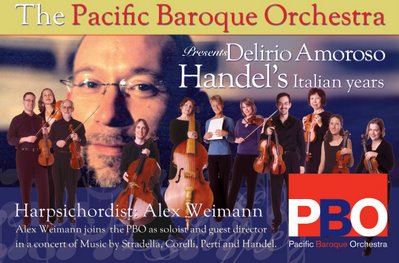
The gloom of the fall rain and the promise of the winter cold are wonderfully compensated by the warmth of going to listen to my friends play music. My friends (incuding violinist/violist Paul Luchkow, below) are the musicians of the Pacific Baroque Orchestra.
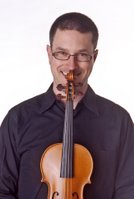
They play baroque music standing up (read below) very close to where I sit in the protective and intimate environment of a church. They perform music that is rarely played on the radio. It is fresh, exciting, challenging and satisfying. I often attend with my friends Graham Walker, Abraham Rogatnick and my granddaughter Rebecca.
-----------------------------------------------------------------------------------------------------
Delirio Amoroso: Handel's Italian Years
Alex Weimann - Guest Director
Washington McClain - Oboe Soloist
Saturday, October 27, 2007, 8.00 p.m.
St. Augustine's Church, Vancouver
2028 West 7th Avenue (corner of Maple and West 7th)
Sunday, October 28, 2007, 2.30 p.m.
West Vancouver United Church
2062 Esquimalt Avenue (at 21st Street and Marine Drive)
----------------------------------------------------------------------------------------------------------------------------------
In September 2002 the Pacific Baroque Orchestra, my favourite Canadian orchestra, and its leader, violinist Marc Destrubé introduced their first CD with the Haydn violin concertos in G, C and A major. The CD cover photo of Destrubé was my last contribution as a two-year trustee of the orchestra.
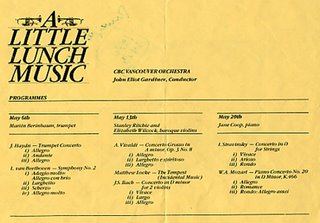
My journey into an intimate musical enlightenment began while munching on a bag of fish and chips (with my daughters Ale and Hilary) on May 13, 1980 at the Orpheum Theater in Vancouver. John Eliot Gardiner (seen here in CBC's Studio 1 where I photographed him in 1979) was directing the CBC Vancouver Orchestra in a series called A Little Lunch Music. The program featured Bach’s concerto in D minor for 2 violins.
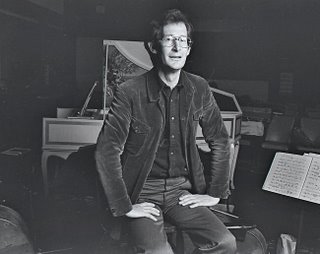
That year Gardiner had begun to verse the ensemble in baroque performance practice, and had introduced period bows and tuning. At the concert Gardiner showed us the difference in sound between the modern and baroque violins. I was hooked to the latter’s quieter but warmer sound.
On Sunday October 27, 1996 at Ryerson Church in Vancouver. A local baroque group founded in 1990, the Pacific Baroque Orchestra, played the Vivaldi Gloria in D major RV 589. The concert not only opened my ears but also my eyes. The musicians, with the exception of the cellists, the bassist and the harpsichordist, to my consternation, were all playing standing up. The big surprise was the all female Electra Women’s Chorus. I had never heard a Vivaldi Gloria with an all female chorus. The performance introduced me to red-haired sisters Caitlin (a mezzo soprano) and Phoebe MacRae (a soprano) who were featured soloists. In later years I would enjoy hearing Caitlin with Vancouver’s Musica Intima and Phoebe as a frequent soloist with the PBO and with the Modern Baroque Opera (now sadly gone).
Soon I found myself going to all the performances of the PBO. I was particularly attracted to sitting in the front rows and hearing the group playing in intimate concert venues, usually churches. It was a surprise to me when two years ago I was called by PBO manager Tom Durrie called me to ask me to be a trustee. My wife suggested that this could be a good career move for me. A more cynical member of the Vancouver Symphony, pianist Linda Lee Thomas told me, “It’s for free pictures, and you’re a photographer.”
My wife was wrong, I spent too much time worrying about the finances of the PBO and little on our own. While I did provide the PBO with free pictures the two-year experience was rewarding and an eye opener in many ways.
I had erroneously thought that as a trustee I would get to see all the concerts for free. No, I had to pay. I thought that being a trustee would be a prestigious endeavor I could boast about. In a city where the arts are suffering what some call a “fund raising burnout” I found I had to help organize golf tournaments. I hate golf. Who would ever know that one of the problems was to find someone who would transport the harpsichord to a concert?
For a while my media connections served me well. When countertenor Matthew White was to appear at a concert with the PBO I called up CBC Radio’s Paul Grant and offered to take to his studio a grown man who sang in a falsetto. The subsequent interview helped fill seats. But soon calling my friend Vancouver Sun music critic Lloyd Dykk put me into the dilemma: was I wearing the hat of friend or of PBO trustee wanting exposure for the band?
As a trustee I found out the nightmarish financial problems that most arts organizations are in. Budgets include federal, provincial and city grants that are not always sure things. Not getting a grant can spell an operating disaster which fund-raising events can only partially alleviate.
After two years as a trustee I feel that the closer contact I had with musicians (many showed up at the board meetings) has given me a further insight into music, baroque music and how it is played.
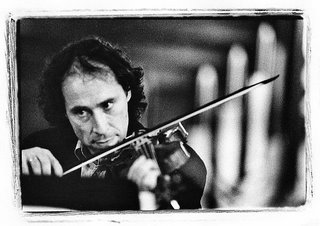
From Destrubé I found out that until Ludwig Spohr invented the violin’s chin rest emotion in music was heard through the composer’s music. “Once the chin rest was there,” Destrubé said, “ the music could be heard in the musician’s head. We could now feel the music and express ourselves through it.” He further explained that the French Revolution marked the decline of rich patrons for music and composers and musicians had to rely on ordinary citizens to foot the bills. This meant larger concert halls where instruments had to be louder. Baroque instruments were beefed up to allow for strings under higher tension. The warmth of the baroque instruments was superseded by the need for a louder sound.
While being a trustee did not, in the end make me feel important, I have learned that sitting up front at a PBO concert is no different from being a king of a European country of the 18th century. These musicians are there, close, playing just for me.
And why do members of the PBO play standing up? Marc Destrubé explained, “Just like rock and roll musicians connect with their audience by standing, I feel we can, too."
PBO
More PBO
And even more PBO
Nelson McLachlan, Sabu & A Manfrotto Super Clamp
Sunday, October 21, 2007
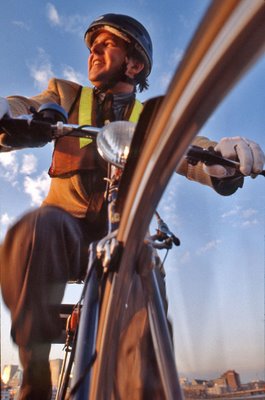 Yesterday Rebecca, Lauren, Rosemary and I watched Alexander Korda's wonderful 1942 film The Jungle Book with Sabu. I particularly thought it appropriate for Rebecca as I wanted her to see the Kipling classic in a film with real people and real animals. I didn't want it to be an animated film. Rebecca liked it (even though Sabu kills Shere Khan and does not run away as in the PC Disney film) and wasn't too sure if the crocodile was real all the time. "Perhaps it was a trained crocodile," she said. Later in the evening she was watching a terrible film with Terrence Stamp (the villain) and Eddie Murphy (the hero). It had lots of special effects and swordplay and levitations. The contrast between the films made me think of the concept of special effects. In The Jungle Book the special effects consisted in trying to make a Hollywood lot look like an Indian jungle. The war made it impossible to shoot it on location. In the 90s I was well known for photographic special effects in the magazine business, before Photoshop brought us penguins in the Sahara. There was one special effects photograph I had taken but I could not remember the name of my subject until I found the old Vancouver Magazine tear sheet from May 1990 yesterday. It had been one of those Sean Rossiter 12th & Cambie columns, this one called The Pedal Pushers. It was a column that was well ahead of its time as it told the story of Nelson McLachlan who, to quote Rossiter: Nelson McLachlan was sitting in his snazzy new metallic brown 1982 Toyota Cellica fastback, idling in the lat-afternoon traffic jam at 41st and Granville, when he had one of those almost religious experiences that occur to all of us but get forgotten by the time we find a parking spot. Barely 22 years old, still paying inflation-era interest on his car loan although the economy was in a freezer, McLachlan suddenly saw that he was working full time for no other reason than to make the payments of his car.
This is crazy, he thought. He pulled into Granville Toyota (at 41st), quickly agreed to accept $7,500 cash for the Celica - it needed vacuuming - and took the Number 3 Road Richmond Express, home to the 18-speed, custom frame bike that had cost him $1000. Rossiter wrote on how McLachlan became chair of the city's Bicycle Advisory Committee and spearheaded making it mandatory for downtown office developers to build bike racks and changing facilities. The article was airing the problem of the fact that cyclists could not ride the SeaBus and buses had no bike racks. In short McLachlan probably helped a lot in making Vancouver an almost bike friendly city. I wonder where he is now and is he still cycling down from Richmond to Vancouver? For the photograph I wanted to do something sharply different from the usual panned shot of a sharp cyclist with a blurred background. I attached a Nikon FM-2 with a fisheye lens and a motor drive to the front hub of McLachlan's bike tire by using a then (and now) legendary Manfrotto Super Clamp. 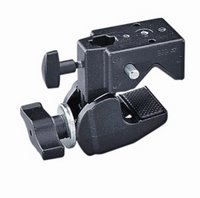 This clamp can bind firmly anything to anything. I had to trust the clamp not to fail as expensive equipment would have literally bitten the dust. I wrapped a remote motor drive button (in the picture here you can see glimpses, on the left side of the picture on the handle bar) and told McLachlan to drive back and forth (but take pictures only on the side that had sun on his face. We shoot three rolls of 36 exposures. Art director Rick Staehling chose this one for the spread and we had a massive argument. It has always been my belief that whoever presses the shutter of a camera is the person who takes the picture. I told Staehling that the photograph had to be photocredited to McLachlan. We finally compromised on a joint credit.
|






















